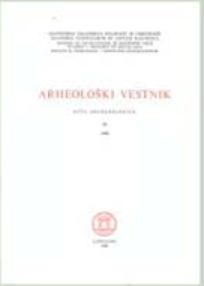Nauportus Fortresses by the River Ljubljanica at Vrhnika
Abstract
The article begins with a summary of present knowledge about Vrhnika-Nauportus, without doubt one of the most interesting early Roman strongholds on present-day Slovene territory. It then goes on to describe the results of protective excavations undertaken at the central part of archaeological Vrhnika on the banks of the Ljubljanica, before the motorway was built. During these excavations it was possible to examine three sections of the southern flank of the walls of a large walled area on the right bank of the Ljubljanica, which was previously known about. We established that the lower layers of the wall were constructed in the dry-walling technique, the inner side was more massive and probably originally higher; a coffer system of thinner, smallwalls and earth filling leant against the outside of this wall while the outermost band of the walls was wider and probably also originally lower. The slanting wooden buttresses of the main inner wall were supported against this outer wall. The whole terrain was originally as high as it is today, so that there is little preservation of ruins and cultural layers in the highest layers of earth. On the south[1]east side of the walls was a diagonally placed, hollow, rectangular tower, built of or faced in wood. The filled dyke between the walls contained a lot of building mortar and some cultural remains from the Hallstatt and very early Roman periods (pl. I, fig. 15,17, 18, 19, 20), while Augustan sigil[1]lata was found on the floor inside the tower and walls (pl. I, fig. 13). A paved way heading south[1]wards probably later intersected the middle part of the southern flank of the walls. The excavation of the south-western corner of the walled area which had already been systematically excavated previously, showed that the south-western tower and west flank of the walls had been built in the same technique as the section now uncovered, only that previous excavators had not been able to observe details because of poor preservation. A special point of interest in the latest excavations was the discovery of a similar walled area, with long buildings leaning against the walls, on the other bank of the Ljubljanica. Finds from the floor level on the left bank of the river served to place the buildings and walls into the period of Augustus (pl. I, fig. 21, 22, 23, 24, 25). From neither bank of the Ljubljanica was it possible to establish whether the area was settled for any length of time after Augustus’s death, a problem which has not been settled conclusively by the archaeolo[1]gical finds published to date, either. The building technique of this Augustan fortress is also very interesting. The coffer construction of the walls and the double wall points towards the pre-Roman tradition followed by the builders of the Roman economic bases on the Karst crossings, while walls reinforced on the outside and supported by wood in the most important spots are found in pure Roman military strongholds of the early Roman period.
Downloads
Downloads
Published
How to Cite
Issue
Section
License

This work is licensed under a Creative Commons Attribution-NonCommercial-ShareAlike 4.0 International License.
Authors guarantee that the work is their own original creation and does not infringe any statutory or common-law copyright or any proprietary right of any third party. In case of claims by third parties, authors commit their self to defend the interests of the publisher, and shall cover any potential costs.
More in: Submission chapter





